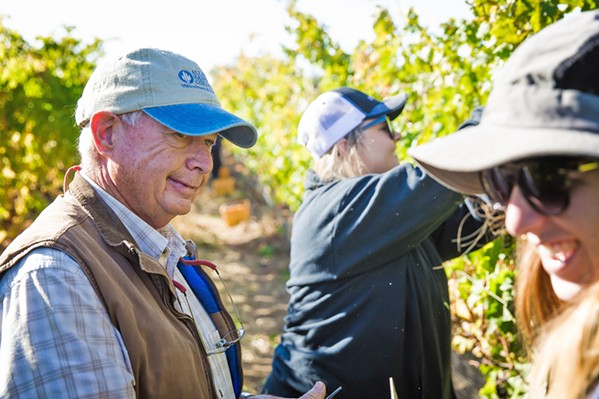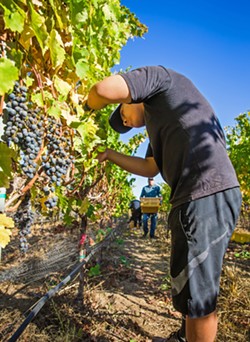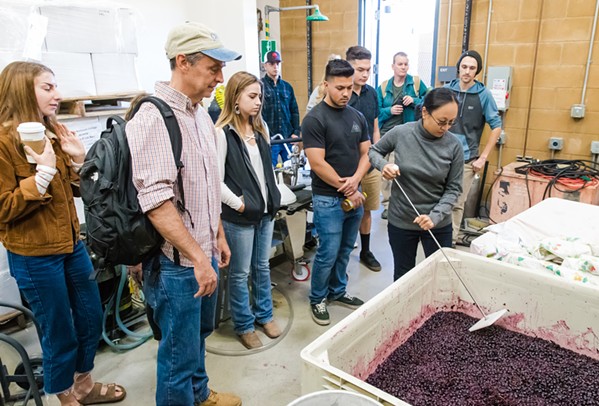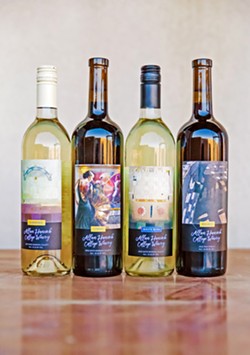There it was, atop a column of paragraphs labeled with rankings of 92, 92, 91 in the buying guide of October 2018's Wine Enthusiast: "91. Allan Hancock 2014 Captain's Reserve Pinot Noir (Santa Barbara County)." The accompanying description was worth savoring: solid wine. Delicious. Rather rich. Quite opulent but easy to enjoy. Editor's choice. $18.
That review sat amid write-ups of pinot noir from some of the state's most well-known and long-established wineries: Tolosa, based in SLO, in the paragraph above with 92 points, priced at more than a hundred bucks. Above that was a Sea Smoke pinot from Sta. Rita Hills at three times Hancock's price and 92 points. Just underneath the college's wine, a Russian River Valley pinot was priced at $80.
On the facing page, halfway down the column of reviews, sat a second write-up: 90 points, Allan Hancock 2016 pinot noir (Santa Barbara County): "Aromas of muddy earth meet with tart, sour cherry and a hint of sweet sage on the nose of this solid bottling made by students at this community college in Santa Maria." $18.

- Photo By Jayson Mellom
- FIELDWORK Ric Fuller (left), head of Allan Hancock College's viticulture operations, takes a break during the Oct. 25 harvest at the Santa Maria campus vineyard. Students work harvests either as volunteers or as part of their viticulture classes.
Hancock, which is one of only three community colleges in the state that can make and sell their own wine, received six more write-ups in Wine Enthusiast's online buying guide since the October magazine ratings.
Most recently, two reviews came on Feb. 1—including the college's highest score yet: 93 points for the 2016 syrah from the campus vineyard.
The notes highlighted the wine's cool-climate character, "from tar, peppercorn, roasted lamb, and black-currant paste on the nose to a tense palate loaded with cracked pepper, rosemary, and game. Fresh acidity provides a juicy quality too."
These strong scores have created a buzz for the college wine program and its wares.
"The cabernet is down to 10 cases or so. We just sold out of the malbec, and now everyone wants the big-scoring syrah," Dave Corey, the college's head of winery operations, said in late February.
As of last fall, Hancock wines were available at about four stores in Northern Santa Barbara County. Since November, Corey's gotten Hancock wines onto the shelves of at least three more Central Coast stores, including Spencer's Fresh Market in Morro Bay.
From a marketing standpoint ratings from magazine reviews, such as Wine Enthusiast, really get people's attention.
"The scores ... make it easier to sell," he said. "I've seen an immediate response."
Corey, who also owns CORE Winery in Orcutt, joined Hancock's winemaking team in mid 2018. While the winemaking program was founded 23 years ago, the college has only been able to sell its campus-made wine since 2014. Now, thanks in part to those recent magazine ratings, Hancock's program is poised to continue growing alongside the Central Coast's burgeoning wine industry.
The wine
"I was happily surprised when I tasted the wines that the college submitted," said Matt Kettmann, Wine Enthusiast's reviewer for the Central Coast. "I tasted them blind, as is Wine Enthusiast policy, and some of the Allan Hancock College wines scored very well against the best wines that the Central Coast has to offer."
The college wines' lowest score of 85 translates to "good: suitable for everyday consumption; often good value." The magazine's scoring ranges from "acceptable" at 80 to 82 points, to "very good" at 87 to 89 points, to "excellent" at 90 to 93, and up to the rare "classic" rating at 98 to 100 points, "the pinnacle of quality," according to the Wine Enthusiast buying guide.

- Photo By Jayson Mellom
- HANDS-ON Students of all ages can learn about every aspect of the wine industry through the Hancock College viticulture and enology program, which has the only bonded only bonded community college campus winery winery south of Napa.
Kettmann said that the wines he tasted for the October ratings marked his first experience with the college's wines, but he's known Corey since long before he took over Hancock's wine production. The wines Corey submitted were made under the former Hancock winery manager, Chris Brown.
"[Dave] asked if he could send them, and I said of course," Kettmann said. "We review everything that's submitted."
It's free to submit wines, he explained, and there's no limit. The regional reviewers sample and write up a couple of thousand wines each month from around the world, and they publish maybe 700 in the magazine each month, he said. The rest are posted in the Wine Enthuiast online wine guide.
"Personally I review 160 to 300 wines a month," Kettmann said, explaining that he sips and spits about a dozen a day, first thing in the morning when his palate's fresh. The magazine's policy is to conduct single-blind tastes, meaning the reviewers know what wines are in the day's lineup but don't know which one's in their glass as they taste.
"I know whether I'm going to taste a pinot and where it's from. There is some context ... but there's also still of lot of chance for surprise," he said. "We try to be as objective as possible."
As for what these reviews might mean for the college's wines, Kettmann said it's great publicity no matter the numbers—and Hancock got more than a passing grade.
"Generally speaking, it's a pretty easy way to get attention for your wines," he said. "It helps to legitimize the [Hancock] program and show people that it's not a college experiment. It's real professionals making it. These wines are solidly made wines."
The winery
Around the west side of the Santa Maria campus off of South College Drive, just before entrance No. 6, there's a blue sign much like all the other blue Hancock signs. Winery, this one says. Blink and you might miss it. After parking in lot 7, look for the industrial gate that slides open to a paved work yard.
In this outdoor area on a sunny fall afternoon, Corey stood over two buckets. He had one hand submerged past his wrist in partially squashed green grapes. Torrontes, he said, samples of the Argentinian variety from the campus vineyard just across the street, near the school's baseball fields. He was checking if they were ready to be harvested.
As he rinsed his hand and wiped it, he mentioned that the heat forecast for that weekend would probably ready the last of the grapes in the student vineyard.

- Photo By Jayson Mellom
- INTRO TO WINEMAKING Alfredo Koch (second from left), instructor and coordinator of the Allan Hancock College viticulture/enology program, leads his class in checking levels of fermentation on grapes in the student winery.
Harvest is only one aspect of wine production that's on Corey's mind. He's bent on getting the word out about the program, including improving the college winery's signage.
"People have to find us," he said.
He noted that more people—on campus and throughout the community—need to know that this tasting room is there, essentially in their backyard.
Corey was hired in June as Hancock's winery operations manager, which means he heads up all aspects of making wine on campus.
"They brought me on here because of my level of success making wine, growing grapes, and my entrepreneurial spirit," Corey said.
He directs and mentors students through every step of the winemaking process, and he's also in charge of sales, social media, and marketing.
"When I got here, there was no social media presence," Corey said. "I'm trying to create demand before I go out. If you don't have demand when you go, you're just throwing things against the wall."
As he ventures out into the community, Corey said he's been met with some surprise. "I didn't even know the college had a winery," he said he hears a lot. He then takes the opportunity to share that Hancock's community college campus bonded winery—the bonded status is what enables a winery to sell its wine—is the third of its kind in the state, alongside Santa Rosa Junior College and Napa Community College.
Selling the winery's wares in turn raises funds for the program and grows awareness in the community, which Corey said he hopes will lead to more students enrolling, growing, harvesting, bottling, selling, and so on. Those students who roll up their sleeves from harvest to marketing can then enter the industry with a season or two under their belts.
"We're building a workforce," he said.
Several area wineries have made donations to the campus winery, from big equipment—including an alkalizer, a destemmer, and presses—to bottles, boxes, and even grapes, Corey said.
Standing outside Hancock's winery, Corey looked like he was working in two quite different worlds: On one side of the work yard stood a hand-written sign inviting visitors to "have a good time." Several picnic benches, a pizza oven, and roses planted in half-barrels were scattered around the north side of the patio. Across the way stood a forklift, at least three types of presses, stainless steel tanks, and industrial bins waiting to be filled with the last of the harvest.
For Corey, this—like any working winery—is indeed the meeting of two worlds: production and hospitality. And he's doing his part to make the outdoor space more of an inviting winery scene.
"I want this to be a major spot for tasting groups. The winery has a built-in hosting [quality] that gives us a leg up," Corey said. "We make 600 cases a year, and realistically we could sell almost all that through the tasting room."
While Corey spoke, instructor Alfredo Koch came through the winery, leading a handful of students. A couple of the students came up to the square vat of fermenting fruit and chatted with Corey about harvest and the grapes' potential.
Koch is the coordinator of the agribusiness/viticulture and enology program. In his softspoken Argentinian accent, he exuded enthusiasm for the winery, the students, and the program he's worked hard to grow over the past 12 years.
"When I came here, there were half the students, half the classes," he said. "It has really grown."
As he glanced around the winery, he listed several milestones, including obtaining the bonded status in 2014, the Hancock wine club, and a new agreement with a university in Bordeaux where Hancock graduates can earn a French bachelor's in viticulture and enology.
The classroom
The following week, Koch was finishing up an Intro to Winemaking lecture in one of the college's life sciences classrooms. Thirteen students of varying ages listened as their professor explained sugar and yeast levels in sparkling wines. Dressed in jeans and work boots with the sleeves of his plaid shirt rolled to his elbows, Koch looked every bit the part of a hands-on instructor. In fact, earlier that morning he'd been harvesting some of the year's last grapes from the campus vineyard.
There in the classroom, he pointed to charts and pictures projected on the screen, highlighting equipment the campus winery has in common with major Champagne producers, which enables the students to try their hands at making sparkling wine.

- Photo By Jayson Mellom
- CHEERS! Hancock College has about a dozen wines for sale in its on-campus winery, and several varieties are available at a growing number of local markets and wine bars between Morro Bay and Solvang.
After his lecture, two students stayed in the classroom to talk about their first semester in the viticulture and enology program. Laura Pedrino mentioned that she volunteered earlier that morning alongside Koch and other students during harvest.
She said that she's learning which parts of the wine industry she likes best. So far, her interest was most piqued by the visiting professional who talked about social media and marketing.
"I don't really see myself working out in the vineyard every day, but I like the business aspect," she said. "I'm starting to have an understanding about wine—while it sounds very romantic—everything that goes behind it, all the hard work and labor."
Pedrino, 32, moved to the Central Coast from LA and works at Saarloos and Sons winery in Los Olivos. She said that after a year in the tasting room, she felt it was time to take the next step and finish a college degree. Knowing that wine is one of the area's biggest industries, she enrolled in Hancock's wine program and is working toward the associate degree in wine business.
Fellow student Steve McCrank also moved up from the LA area—the day before Hancock's semester began, he said. He was looking for a second career after working 22 years as a newspaper photographer.
"I'd been coming up here doing wine tasting for years; I went to Cal Poly SLO, and I knew the area well," McCrank said. "We knew this was where we wanted to be ... if you want to live up here and work, you go into the wine industry."
He said he was excited to learn about Hancock's program because the cost is low, and he can earn a certificate to launch him into the industry. Right now, he's looking into production and winemaking.
"I'm using this more to explore and see exactly where I fit in," said McCrank, who works at Rancho Sisquoc winery. "So far my experience has been great—working and in school, everybody's been accepting and easygoing and eager to teach you to move on. It's like if you work hard, this is the kind of industry that will reward you for that. A lot of places don't do that anymore."
Koch noted that not only do his students get to venture outside the classroom and roll up their sleeves in a working winery and vineyard, they get the benefit of industry professionals coming into the classrooms—either to stand at the front or sit alongside them.
"Many students down here take one or two courses because they need them for work. Many are even the sons and grandchildren of owners of very large wineries in the state who come here to take classes," Koch said. "Some of the owners have taken one or two classes and ... they share a lot of stories."
While the students and their professor chatted, Dean of Academic Affairs Richard Mahon joined the conversation at one of the science classroom's long black tables.
"It's nice to have students who have different skills come into the program because while you're learning about what we teach, you have skills that you can share with other students," Mahon said. "And that makes the program stronger as well."
Koch said he remembered a few engineers from Vandenberg Air Force Base who took some of his classes and shared with him and other students their expertise about climate. "They make the class interesting," he said.
The instructor himself offers the best of both worlds to his students. Koch grew up in Argentina working in his grandfather's vineyard in the summers, and he has a master's in agriculture from Cal Poly, an MBA from the University of Pittsburgh, and a Ph.D. from Davis' viticulture and enology program—the same doctorate program that Merilark Padgett-Johnson went through before founding Hancock's viticulture program in 1996.
As the community college's program continues to grow future vintages and vintners alike, its students take with them a well-rounded set of skills wherever they choose to go, according to Koch and Mahon. With a one-year certificate, students can enter the workforce, and with a two-year associate degree, they can either enter the industry or transfer to a university.
"The students who want to go straight into the workforce wind up with more theoretical background and foundation than would otherwise be the case because the courses have to work for transfer [students] as well," Mahon said. "And the students who want to transfer have more hands-on experience."
"We try to really prepare them to succeed and do well," Koch said.
That support and flexibility are what attracted Pedrino and McCrank to the program, and while both students have come across many people who are familiar with Hancock's program, they're looking forward to growing awareness in the community.
"I'm excited to see how the winery and tasting room is coming along," Pedrino said. "I'm excited to see more promotion and getting people to know that this is here and you can come taste the wines that all the students have worked so hard on." Δ
Associate Editor Andrea Rooks can be reached at [email protected].
Comments